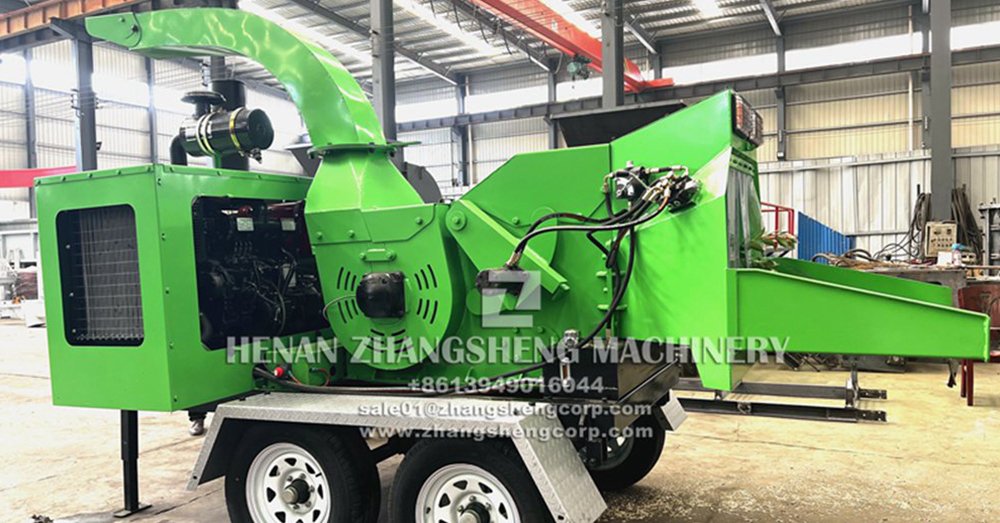Got a pile of recently cut branches or logs? They might be wet from rain or just being green. You might wonder if your wood chipper can handle them like it handles dry wood. It's a common question people ask.
Yes, wood chippers can generally work with wet wood and branches, but it can be harder on the machine, less efficient, and increases the chance of clogging compared to chipping dry wood. Larger, more powerful chippers handle wet material better than smaller ones.
Chipping wood is a great way to process waste. But the condition of the wood makes a big difference in how the job goes. Wet wood behaves differently than dry wood. Knowing this helps you operate your machine better and avoid problems. Let's look closer at chipping wood when it's wet.
Does wood need to be dry before chipping?
You just cut down a tree or trimmed some bushes. You want to chip the waste right away. But maybe it rained last night, or the wood is still very green and full of sap. You might think you have to wait for it to dry. Is that true?
Wood does not need to be completely dry before chipping, but dry wood is easier to chip and results in cleaner chips. Wet wood is heavier and can make the chipper work harder, potentially leading to slower feeding, more wear on parts, and a higher risk of clogs.
In my years working with wood chippers, I've seen machines handle all sorts of wood conditions. At Zhangsheng, we build robust chippers designed for tough jobs, including processing different types of wood in various states. However, there's definitely a difference when you're chipping dry wood versus wet wood. Think about trying to cut dry wood with a knife versus cutting wet wood; the wet wood feels denser and can offer more resistance. A wood chipper's blades work by slicing through the wood fibers. When wood is wet, these fibers are saturated with water. This makes the wood heavier and less brittle. Instead of breaking cleanly under the blade's force, wet wood can sometimes tear or mush more. This requires more power from the engine. The blades have to work harder to get through the material. Also, the chips produced from wet wood are often heavier and stickier than chips from dry wood. This can cause problems as the chips travel through the discharge chute. They don't flow out as smoothly. They can clump together and build up, leading to clogs. Clogging is a major issue because it stops the work and requires time to clear. It can also put stress on the machine if the engine continues to run while the chute is blocked. So, while a wood chipper can process wet wood, it's not the ideal condition for peak performance or machine longevity. If you have the choice, chipping wood when it's dry will always be more efficient and put less strain on your equipment. However, sometimes waiting isn't practical.
Why Dry Wood is Easier:
Lighter: Dry wood weighs less, making it easier to feed and transport through the machine.
Less Resistance: Fibers are more brittle, allowing for cleaner cuts with less power needed.
Cleaner Chips: Chips are lighter and less sticky, flowing freely through the discharge chute.
Less Wear: Less strain on the engine, belts, and bearings. Blades stay sharp longer.
So, while you don't have to wait until wood is bone dry, chipping drier wood is generally better for your machine and for the quality of the chips produced.

Can you shred wet branches by wood chipper?
You've got a big pile of branches that just came down in a storm. They are wet and leafy. Can your wood chipper handle these? Or will it just jam up? Dealing with wet branches is a common situation for anyone with a chipper.
Yes, you can shred wet branches using a wood chipper, but expect it to be slower and potentially require more attention to prevent clogs. Wet branches are heavier and the leaves on them can contribute to blockages. Machine size and design play a big role in how well it handles them.
From building chippers at Zhangsheng, I know that wet branches are one of the tougher tests for a machine. A clean, dry branch goes through smoothly. A wet branch, especially one with a lot of wet leaves still attached, is a different story. The weight of the water makes the branches heavier. This can make feeding them harder, especially in smaller chippers that rely more on gravity or smaller feed rollers. The real challenge often comes from the leaves and smaller twigs. When they are wet, they become matted and don't flow well. They can clump together and stick to the inside of the chipper's housing or the discharge chute. This is where clogs start. I've seen it many times; a customer tries to feed a large volume of wet, leafy material too fast, and the machine struggles, then jams. Powerful industrial chippers, like some we make, have stronger engines, larger feed rollers, and bigger discharge openings. These features help them push through wetter, heavier, and more inconsistent material like wet, leafy branches. The force of the feed rollers can help break up clumps. The bigger engine provides the extra power needed to cut through the denser, wet wood. The larger discharge reduces the chance of chips building up and blocking the exit. However, even with a powerful machine, you still need to feed wet branches more carefully than dry ones. Go slower. Don't try to force too much in at once. Break up big piles of wet, leafy material into smaller batches. If your chipper has adjustable feed speed, slow it down when processing wet branches. Check the discharge chute often to make sure chips are flowing freely. If you hear the engine bogging down or see the flow of chips slowing, stop feeding material until the machine clears. Sometimes, feeding a dry branch after a few wet ones can help push the sticky wet material through.
Tips for Chipping Wet Branches:
Feed Slowly: Don't rush the process.
Mix Materials: If possible, alternate wet branches with some dry wood or branches.
Check for Clogs: Keep an eye on the discharge chute.
Keep Blades Sharp: Sharp blades cut wet wood better and reduce strain.
Consider Machine Size: Smaller chippers will struggle more with wet material than large, commercial ones.
Chipping wet branches is possible, but it requires patience and attention to avoid problems. The size and power of your chipper are key factors in how well it performs this task.

Can wood chipper work with wet wood?
So, we know branches can be tricky when wet, and ideally, wood is dry. But can a wood chipper actually work with larger pieces of wet wood, like sections of a trunk or larger limbs? This applies whether the wood is freshly cut or just soaked from rain.
Yes, a wood chipper is designed to process wood, regardless of its moisture content, although wet wood presents more challenges. The core function of cutting wood is possible with wet material, but it demands more from the machine and increases the likelihood of operational issues like reduced throughput and clogging.
Building wood chippers means making them tough enough to handle the real world. And in the real world, wood isn't always perfectly dry. We design our Zhangsheng chippers to handle various conditions, including wet wood. The fundamental cutting mechanism – the knives slicing against an anvil – still works on wet wood. However, the experience is different. When you feed a piece of wet wood, it's heavier. The machine's infeed system has to work harder to pull it in. Once inside, the cutting drum or disc has to exert more force to slice through the saturated fibers. This puts a higher load on the engine. You will likely hear the engine RPMs drop more significantly when processing wet wood compared to dry wood of the same size. The chip output from wet wood is often heavier and more prone to sticking together. This affects how well the chips are blown out of the discharge chute. With dry chips, the air flow created by the cutter disc or drum easily propels them out. With wet chips, they can clump and build up, particularly in turns or restrictions in the chute. This is the main reason for clogs when chipping wet wood. Industrial and commercial-grade chippers are generally built with stronger engines, more robust feed systems, and often have blowers or redesigned chutes to better handle the output of wet, heavy chips. For example, our horizontal grinders, which can process large volumes, are built with systems that can power through wet, bulky material, though even these machines perform best with drier inputs. Small, residential chippers with lower horsepower engines will struggle much more with wet wood. They might feed very slowly, bog down easily, or clog frequently. The temperature can also play a role; cold, wet wood might be even harder to process than warm, wet wood. Ultimately, while a chipper can work with wet wood, you must adjust your expectations and operational practices. You will likely process less volume per hour, and you'll need to be more vigilant about monitoring the machine's performance and checking for clogs. Keeping the blades sharp is especially important when dealing with wet wood, as sharp blades cut more efficiently and reduce the strain on the engine.
Working with Wet Wood:
| Aspect | Impact of Wet Wood | Operational Considerations |
|---|---|---|
| Weight | Heavier material to feed and process | Slow down feeding, ensure sufficient engine power |
| Cutting | More resistance, requires more power | Maintain sharp blades, don't overload engine |
| Chip Output | Stickier, heavier chips, clumping risk | Monitor discharge chute, clear clogs promptly |
| Machine Strain | Increased load on engine, belts, bearings | Regular maintenance, don't push machine too hard |
| Efficiency | Slower processing, reduced throughput | Accept lower productivity, plan for longer job |
In conclusion, wood chippers can handle wet wood, but it makes the job harder. Be prepared for slower processing, watch for clogs, and take care of your machine by not pushing it too hard.
Conclusion
You can use a wood chipper on wet wood, but it's harder than chipping dry wood. Wet wood causes more strain, slower work, and potential clogs. While possible, it's not ideal for performance or your machine's lifespan.


